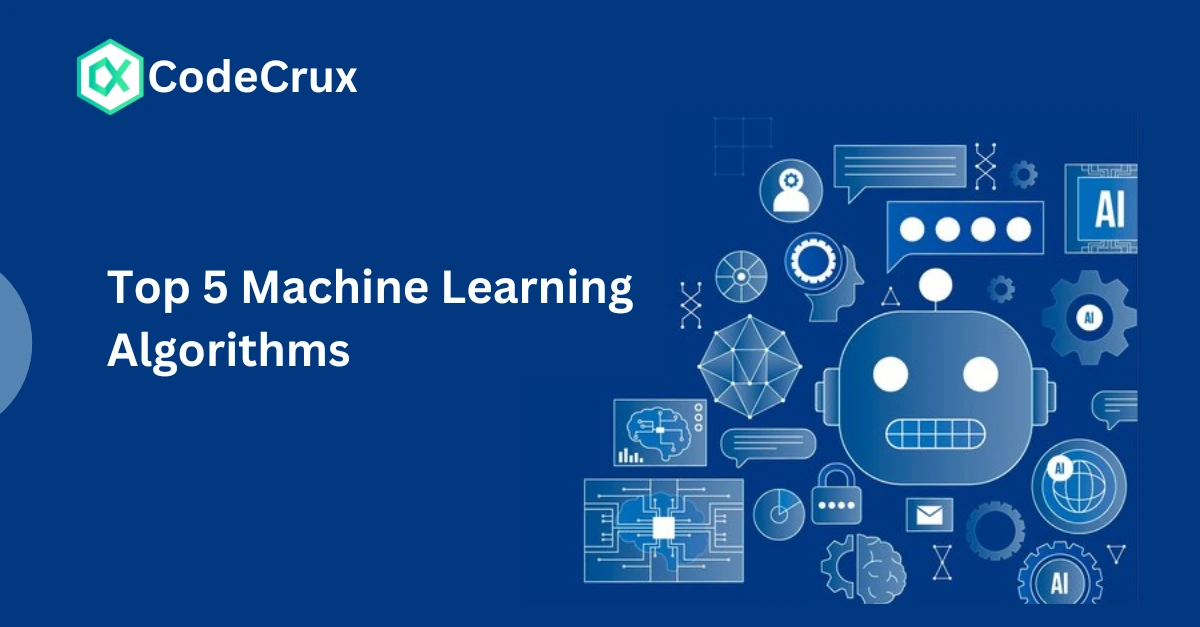Top 5 Machine Learning Algorithms

Machine learning (ML) is transforming the way we approach data-driven decision-making. It enables systems to learn from data, adapt to new inputs, and perform tasks with remarkable accuracy—all without being explicitly programmed. At the core of ML are powerful algorithms that drive these advancements. Here, we dive into the top five machine learning algorithms that have become indispensable across industries.
1. Linear Regression: The Foundation of Prediction
Linear Regression is a cornerstone of supervised learning, modeling the relationship between dependent and independent variables by fitting a straight line through data points.
Why It’s Essential:
-
Simple yet effective for understanding and predicting continuous variables.
-
Minimizes error using a least-squares approach.
Where It’s Used:
-
Predicting sales, market trends, or stock prices.
-
Estimating real estate values based on location and property features.
Real-World Example: Determining housing prices based on square footage, neighborhood, and other factors.
2. Logistic Regression: The Classification Expert
Despite its name, Logistic Regression shines in classification tasks by estimating the probability of a categorical outcome.
Key Features:
-
Outputs probabilities using a sigmoid function for binary or multi-class classification.
-
Efficient for separating data into distinct groups.
Applications:
-
Spam detection for emails.
-
Predicting customer churn or loan defaults.
Real-World Example: Identifying whether a transaction is fraudulent or legitimate.
3. Decision Trees: The Intuitive Problem Solver
Decision Trees are intuitive, visually appealing models that split data into branches based on feature values, leading to specific outcomes at leaf nodes.
Why It Stands Out:
-
Easy to interpret and explain to non-technical stakeholders.
-
Handles both categorical and numerical data effortlessly.
Where It Excels:
-
Customer segmentation and personalized marketing.
-
Assessing credit risk or diagnosing medical conditions.
Real-World Example: Segmenting customers into loyalty tiers based on their purchase history and preferences.
4. Support Vector Machines (SVM): The Boundary Creator
SVM is a powerful algorithm that excels at classification tasks by finding the optimal hyperplane to separate data points into distinct categories.
Unique Strengths:
-
Effective in high-dimensional spaces with complex boundaries.
-
Robust against overfitting when properly tuned.
Applications:
-
Image and handwriting recognition.
-
Bioinformatics, such as cancer classification.
Real-World Example: Classifying whether a tumor is malignant or benign based on medical imaging data.
5. K-Means Clustering: The Unsupervised Organizer
K-Means is a go-to algorithm for unsupervised learning, grouping data into clusters based on similarities. It’s invaluable for exploring patterns without predefined labels.
Why It’s Powerful:
-
Identifies hidden structures in data for deeper insights.
-
Scales well with large datasets.
Where It Shines:
-
Market segmentation for tailored customer experiences.
-
Grouping similar documents, images, or users.
Real-World Example: Categorizing users into behavioral segments for targeted advertising campaigns.
Conclusion: Choosing the Right Algorithm
The effectiveness of these algorithms depends on the specific problem and dataset at hand. Mastering them not only lays the foundation for a successful machine learning career but also empowers you to solve real-world challenges with confidence. Start experimenting, fine-tune your models, and unlock the true potential of machine learning in your projects!